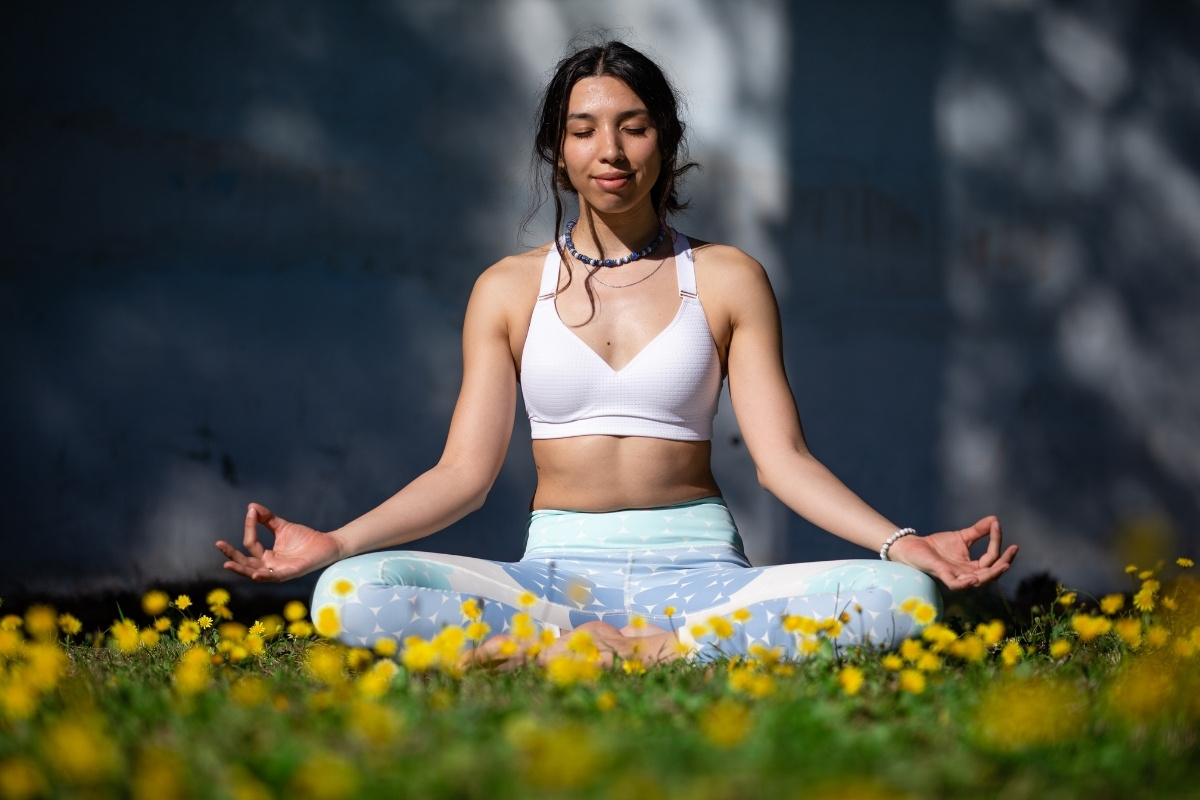These days, it feels like everyone’s running on empty.
Between packed schedules, digital overwhelm, and constant stress, more and more people are searching for a way to reset—not just physically, but mentally and emotionally too. That’s where wellness retreats come in: not as a luxury, but as a much-needed pause.
Retreats have evolved beyond just yoga or movement.
They’ve become safe spaces for healing, self-reflection, and deep nourishment—blending mindful practices, nature, adventure, and health-conscious meals.
And as a yoga teacher, you’re in a unique position to craft an experience that brings all of that together.
By weaving in trends like mindfulness, plant-based nutrition, movement therapy, and emotional well-being, you can offer your students more than just a getaway—you can offer them transformation.
Here’s how to create a retreat that’s not only aligned with what people truly need right now, but one that leaves a lasting impact.

1. Define Your Health-Centered Vision and Goals

A clear vision with health and wellness at its core will guide every aspect of your retreat, from the curriculum and activities to the location and target audience. Establishing specific wellness goals will help create a cohesive and meaningful experience for participants.
Target Audience
Are you catering to women’s wellness, individuals seeking mental clarity, stress reduction, or physical fitness? Depending on your focus, your retreat might attract different groups—such as professionals struggling with burnout, people recovering from physical or mental health issues, or fitness enthusiasts looking to enhance their well-being.
You might also consider retreats centered on specific groups, like women, corporate teams, or those recovering from trauma. Each group will have unique needs, and understanding their motivations will help tailor the retreat to their health goals.
Core Health Objectives
Will your retreat help participants manage stress, improve mental clarity, enhance physical fitness, or focus on emotional healing? Defining your health objectives early on will help shape the curriculum, activities, and themes you choose.
For example, a retreat focused on mental health might emphasize meditation, mindful breathing, and stress-relieving movement, while a fitness-focused retreat could incorporate dynamic yoga flows, strength training, and recovery sessions.
Duration: Consider the time commitment required to achieve the wellness goals you’ve set. A weekend retreat may be suitable for local participants looking for a quick mental reset, while a week-long or even 10-day retreat might be ideal for those looking to make deeper, long-lasting changes to their physical and mental health.
By defining these elements, you’ll attract participants whose wellness goals align with the experience you’re offering, ensuring they get the most out of your retreat.
2. Choose a Location that Encourages Movement, Healing, and Serenity

The retreat location plays a significant role in setting the tone for the experience. It should encourage both physical movement and mental relaxation while providing the tranquility necessary for healing and self-reflection. Choose locations that support outdoor activities, encourage mindful movement, and provide space for mental clarity.
Atmosphere and Environment
Select a venue that complements your health goals. For example, a mountain lodge offers hiking and natural terrain for outdoor fitness activities, while a beach setting (think Bali wellness retreat) might encourage walking meditations along the shore. The environment should invite participants to reconnect with nature, which itself is a proven way to boost mental and emotional well-being.
Research shows that time spent in nature can lower cortisol levels and improve mood, so a natural, serene environment is key for promoting both physical and mental restoration.
Accessibility and Wellness Amenities
While remote destinations might provide an appealing escape from the stresses of everyday life, ensure that the location is accessible without undue hardship. Consider logistics like nearby airports, local transportation options, and easy-to-follow travel directions.
Additionally, the venue should offer amenities that support your retreat’s health and wellness focus, such as fitness studios, meditation spaces, and outdoor activity areas.
If possible, select locations with spa services or access to natural healing resources (e.g., hot springs or mineral baths) to further enhance the participants’ relaxation and rejuvenation.
Venue Facilities for Holistic Wellness
Ensure that the space includes areas for both movement and mindfulness. For yoga and fitness, you’ll need spaces conducive to dynamic group activities, as well as more intimate settings for meditation or mindfulness workshops.
Onsite wellness facilities—like a pool, sauna, or massage area—can further support the overall goal of nurturing participants’ health and mental well-being.
3. Design a Movement and Mental Health-Focused Schedule

The schedule is the heart of your retreat, and its design should reflect a balance between physical movement, mental health practices, and rest. Incorporating activities that promote both physical and mental wellness will create a more holistic and healing experience.
Daily Movement Practices
Movement is a vital component of overall health and well-being. Design your schedule to include 1-2 yoga sessions per day, tailored to different energy levels and goals. For instance, a morning session might focus on energizing practices like Vinyasa flow or Ashtanga yoga, while evening classes can emphasize slow, restorative yoga, or practices designed for relaxation and recovery.
Additionally, you could offer complementary movement-based activities like Pilates, Tai Chi, or Qi Gong, which blend physical fitness with mindful breathwork and mental clarity.
Mental Health Workshops
Mental wellness is a growing trend in the health industry. Address participants’ mental health through workshops that explore mindfulness, emotional resilience, and stress management. Include practices such as guided meditation, breathwork, or emotional release techniques (like EFT tapping).
For deeper emotional healing, you might consider workshops that integrate creative expression, such as journaling, art therapy, or sound healing, which offer participants alternative outlets for emotional processing and stress relief.
Mindful Integration of Rest
Over-scheduling activities can lead to burnout, even in a wellness retreat. Ensure that participants have ample time for solo reflection, journaling, or simply enjoying the surroundings in silence. This unscheduled time helps participants internalize their experiences, deepening their personal insights and emotional processing.
4. Offer Nourishing, Plant-Based Meals that Support Mental and Physical Health

Nutritional wellness is a core element of any health-focused retreat, as diet significantly influences mood, energy levels, and overall well-being. Current trends emphasize plant-based, whole-food nutrition for its benefits on both the mind and body.
Plant-Based, Whole-Food Menus
Focus on fresh, organic, and local ingredients when possible, offering meals that are both delicious and health-conscious. Whole foods—such as leafy greens, whole grains, nuts, and legumes—are packed with nutrients that support mental clarity and physical vitality.
Superfoods like quinoa, turmeric, chia seeds, and kale can be incorporated into the menu to enhance the nutritional profile. You can also highlight the benefits of certain foods for mental health, such as omega-3-rich sources like walnuts or flaxseeds, which support brain function and reduce inflammation.
Meals that nourish and elevate the retreat.
From gluten-free to plant-based, our guide helps you craft menus as intentional as your classes.

Mindful Eating Practices
Encourage participants to approach each meal as part of their wellness journey by introducing mindful eating techniques. This can include silent breakfasts, where participants focus on the textures and flavors of their food, or a brief gratitude meditation before meals to promote awareness and appreciation for nourishment. Mindful eating practices foster a deeper connection between body and mind, encouraging healthier relationships with food.
Dietary Diversity and Inclusivity
As people become more conscious of their dietary needs, it’s essential to cater to a variety of preferences and restrictions. Ensure that you provide gluten-free, vegan, and allergy-friendly options, and consider hosting a plant-based cooking class or nutrition workshop to educate participants about how to integrate healthy eating habits into their daily lives.
5. Foster Mental Wellness Through Community and Individual Reflection

Retreats provide a unique opportunity for both social connection and personal growth. Mental health is greatly supported through a sense of belonging, shared experiences, and space for introspection.
Community Circles for Mental Health
Create opening and closing circles to foster a sense of community and support. In these sessions, participants can share their intentions, challenges, and reflections in a safe, non-judgmental environment.
These gatherings can provide emotional release and connection, which is especially important for individuals dealing with stress or mental health challenges. Community activities, such as group hikes, partner yoga, or team-building exercises, can also promote connection and collaboration.
Solo Reflection and Journaling
Offer participants time for solo reflection to process their emotions and experiences. Journaling prompts that encourage participants to explore themes like gratitude, self-care, and emotional resilience can be powerful tools for mental healing. You might also consider introducing walking meditations or contemplative time in nature, which can further support emotional balance and mindfulness.
6. Leverage Wellness Trends in Marketing and Promotion

In an increasingly health-conscious world, marketing your retreat with an emphasis on current wellness trends—such as mindfulness, movement therapy, and plant-based living—can help attract participants. Your marketing should communicate the transformational benefits of the retreat.
Storytelling with a Wellness Focus
Use storytelling to connect with potential participants. Share your personal journey and how the retreat’s focus on movement, mental health, and plant-based nutrition aligns with popular wellness trends.
Highlight the physical and emotional benefits they’ll experience, from increased mindfulness and stress relief to enhanced fitness and vitality.
If you’re looking to strengthen your retreat brand and build deeper connections with your audience, take inspiration from how thoughtful storytelling and community-building can make a lasting impact—explore what wellness brands can learn from Once Upon A Farm to apply these lessons to your own retreat experience.
Leveraging Visuals and Testimonials
Use high-quality photos and videos to showcase the natural beauty of the retreat location, the group activities, and the healthy meals you’ll provide. Testimonials from past participants, particularly those who experienced positive changes in their mental and physical health, can build trust and inspire potential attendees.
7. Manage Wellness-Related Practicalities

Hosting a retreat that involves physical activity and mental health practices comes with responsibilities regarding safety, health, and logistics.
Health and Safety Measures
Ensure that your venue has appropriate health and safety protocols in place. Offer first-aid resources and have contingency plans for medical emergencies, especially if you’re hosting the retreat in a remote area.
If you are incorporating vigorous physical activities, ensure participants understand any health prerequisites and have access to proper care if needed. Encourage all participants to secure travel or health insurance, particularly if your retreat is held abroad.
Preparation and Travel Tips
Offer practical guidance for participants by sharing health-related tips for their stay. Include information about staying hydrated, packing for weather changes, and any wellness-specific items (like yoga mats or props) they might need to bring.
8. Follow-Up for Long-Term Health Impact

The retreat’s impact should extend beyond the time spent on-site. To ensure lasting benefits, provide participants with tools to continue their mental and physical wellness journeys.
Post-Retreat Resources for Continued Health
Send participants follow-up emails with resources to help them maintain their well-being. Offer at-home yoga sequences, guided meditations, or nutrition tips that align with the practices introduced during the retreat. Virtual group check-ins or one-on-one coaching can help participants stay committed to their wellness goals and maintain momentum after the retreat.
Retreat Reflections and Support
Encourage participants to reflect on their retreat experience and how it has influenced their health and wellness journey. Consider offering a retreat reunion—either in person or virtually—several months later to reinforce the sense of community and support they developed during the retreat.
Create a Website That Supports (and Sells) Your Retreat Vision
Once you’ve mapped out the experience—from the morning movement sessions to the nourishing meals and moments of stillness—you’ll need a way to bring it all to life online.
A strong retreat website doesn’t just showcase what you’re offering—it builds trust, answers questions, and makes it easy for the right people to say yes.
That’s where TheFlowOps comes in. Built specifically for yoga teachers and wellness facilitators, it’s a simple, no-code platform that helps you launch a professional site in under 30 minutes—without the tech stress.
Whether you’re hosting a wellness weekend, a plant-based detox, or a movement-focused retreat, TheFlowOps gives you everything you need to:
- ✨ Pick from wellness retreat-specific templates
- 💳 Add built-in booking and checkout options so guests can reserve their spot and pay with ease
- 📧 Automate confirmation emails and stay on top of communication
- 🌿 Showcase your offerings with photo galleries, schedules, inclusions, and testimonials
- 🔗 Integrate with email marketing and forms for lead capture and follow-up
- 🌍 Use a custom domain to align with your retreat brand
- 🎉 Start with a 7-day free trial—no credit card required, and no hidden fees
Over to You
Hosting a health and wellness retreat as a yoga teacher is a deeply rewarding endeavor.
It provides an opportunity to guide participants through transformative experiences, help them deepen their practice, and cultivate a greater sense of well-being.
By focusing on your vision, planning meticulously, and creating an environment that fosters community and growth, you can craft retreats that leave lasting impressions on participants.
Remember, a successful retreat is not just about offering yoga classes—it’s about creating a holistic journey that empowers, inspires, and rejuvenates everyone involved, including yourself as the teacher.
With these tips, you can ensure your health and wellness retreats are powerful, meaningful, and truly unforgettable.




